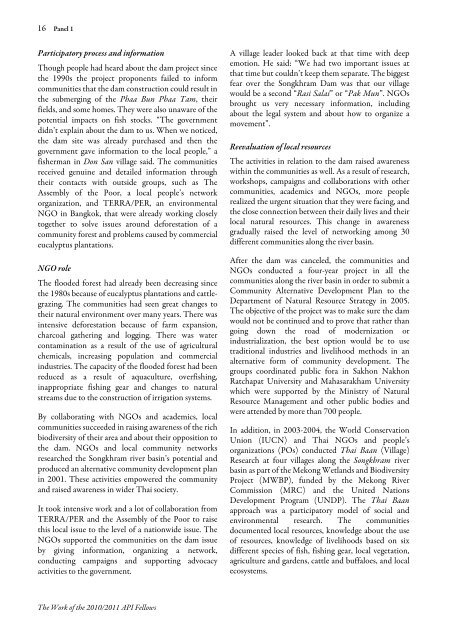Untitled - Api-fellowships.org
Untitled - Api-fellowships.org
Untitled - Api-fellowships.org
Create successful ePaper yourself
Turn your PDF publications into a flip-book with our unique Google optimized e-Paper software.
16 Panel 1Participatory process and informationThough people had heard about the dam project sincethe 1990s the project proponents failed to informcommunities that the dam construction could result inthe submerging of the Phaa Bun Phaa Tam, theirfields, and some homes. They were also unaware of thepotential impacts on fish stocks. “The governmentdidn’t explain about the dam to us. When we noticed,the dam site was already purchased and then thegovernment gave information to the local people,” afisherman in Don San village said. The communitiesreceived genuine and detailed information throughtheir contacts with outside groups, such as TheAssembly of the Poor, a local people’s network<strong>org</strong>anization, and TERRA/PER, an environmentalNGO in Bangkok, that were already working closelytogether to solve issues around deforestation of acommunity forest and problems caused by commercialeucalyptus plantations.NGO roleThe flooded forest had already been decreasing sincethe 1980s because of eucalyptus plantations and cattlegrazing.The communities had seen great changes totheir natural environment over many years. There wasintensive deforestation because of farm expansion,charcoal gathering and logging. There was watercontamination as a result of the use of agriculturalchemicals, increasing population and commercialindustries. The capacity of the flooded forest had beenreduced as a result of aquaculture, overfishing,inappropriate fishing gear and changes to naturalstreams due to the construction of irrigation systems.By collaborating with NGOs and academics, localcommunities succeeded in raising awareness of the richbiodiversity of their area and about their opposition tothe dam. NGOs and local community networksresearched the Songkhram river basin’s potential andproduced an alternative community development planin 2001. These activities empowered the communityand raised awareness in wider Thai society.It took intensive work and a lot of collaboration fromTERRA/PER and the Assembly of the Poor to raisethis local issue to the level of a nationwide issue. TheNGOs supported the communities on the dam issueby giving information, <strong>org</strong>anizing a network,conducting campaigns and supporting advocacyactivities to the government.A village leader looked back at that time with deepemotion. He said: “We had two important issues atthat time but couldn’t keep them separate. The biggestfear over the Songkhram Dam was that our villagewould be a second “Rasi Salai” or “Pak Mun”. NGOsbrought us very necessary information, includingabout the legal system and about how to <strong>org</strong>anize amovement”.Reevaluation of local resourcesThe activities in relation to the dam raised awarenesswithin the communities as well. As a result of research,workshops, campaigns and collaborations with othercommunities, academics and NGOs, more peoplerealized the urgent situation that they were facing, andthe close connection between their daily lives and theirlocal natural resources. This change in awarenessgradually raised the level of networking among 30different communities along the river basin.After the dam was canceled, the communities andNGOs conducted a four-year project in all thecommunities along the river basin in order to submit aCommunity Alternative Development Plan to theDepartment of Natural Resource Strategy in 2005.The objective of the project was to make sure the damwould not be continued and to prove that rather thangoing down the road of modernization orindustrialization, the best option would be to usetraditional industries and livelihood methods in analternative form of community development. Thegroups coordinated public fora in Sakhon NakhonRatchapat University and Mahasarakham Universitywhich were supported by the Ministry of NaturalResource Management and other public bodies andwere attended by more than 700 people.In addition, in 2003-2004, the World ConservationUnion (IUCN) and Thai NGOs and people’s<strong>org</strong>anizations (POs) conducted Thai Baan (Village)Research at four villages along the Songkhram riverbasin as part of the Mekong Wetlands and BiodiversityProject (MWBP), funded by the Mekong RiverCommission (MRC) and the United NationsDevelopment Program (UNDP). The Thai Baanapproach was a participatory model of social andenvironmental research. The communitiesdocumented local resources, knowledge about the useof resources, knowledge of livelihoods based on sixdifferent species of fish, fishing gear, local vegetation,agriculture and gardens, cattle and buffaloes, and localecosystems.The Work of the 2010/2011 API Fellows
















